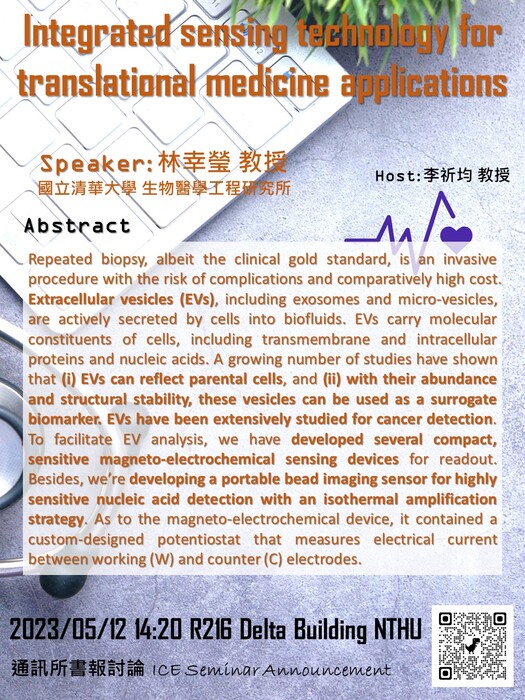2023/05/12 (Fri.) 14:20-林幸瑩 教授 國立清華大學 生物醫學工程研究所—Integrated sensing technology for translational medicine applications

Date & Time:
2023 / 05 / 12 (Fri) 14:20 - 16:20
Location:
Delta Building R216, NTHU
Speaker:
林幸瑩 教授
國立清華大學 生物醫學工程研究所
Topic:
Integrated sensing technology for translational medicine applications
Abstract:
Repeated biopsy, albeit the clinical gold standard, is an invasive procedure with the risk of complications and comparatively high cost. Extracellular vesicles (EVs), including exosomes and micro-vesicles, are actively secreted by cells into biofluids. EVs carry molecular constituents of cells, including transmembrane and intracellular proteins and nucleic acids. A growing number of studies have shown that (i) EVs can reflect parental cells, and (ii) with their abundance and structural stability, these vesicles can be used as a surrogate biomarker. EVs have been extensively studied for cancer detection; they often reflect global tumor burden and heterogeneity, overcoming sampling biases. Moreover, the amount and molecular profiles of cancer-derived EVs highly correlate with tumor burden and treatment efficacy. To facilitate EV analysis, we have developed several compact, sensitive magneto-electrochemical sensing devices for readout. Besides, we’re developing a portable bead imaging sensor for highly sensitive nucleic acid detection with an isothermal amplification strategy. As to the magneto-electrochemical device, it contained a custom-designed potentiostat that measures electrical current between working (W) and counter (C) electrodes. A constant potential was applied between working and reference (R) electrodes during the measurement. The device operated standalone and communicated with external devices for data logging (Bluetooth/USB). When benchmarked against a benchtop system (SP-200, Bio-Logic), the point-of-care device offered comparable performance despite being much cheaper (<$100) and smaller (5 × 3 × 2 cm3) in size. We optimized streamlined EV analyses. A key feature is the integration of EV isolation and detection into a single platform: magnetic beads are used for EV capture and labeling, and bead-bound EVs are detected through electrochemical sensing. This strategy offers practical advantages: (i) the assay achieves high detection sensitivity, by combining the merits of magnetic enrichment with enzymatic amplification; (ii) through the electrical detection scheme, sensors can easily be miniaturized and expanded for parallel measurements. The resulting was superior to conventional methods (e.g., ELISA., Western blotting) in speed and sensitivity.
Biography:
Dr. Hsing-Ying Lin serves as an Assistant Professor in the Institute of Biomedical Engineering at National Tsing Hua University since 2020. Before relocating to NTHU, she was a Research Fellow in the Center for Systems Biology, Massachusetts General Hospital, Harvard Medical School. She got prestigious MGH FMD fellowship (2018) and NIH T32 training grant (2019) in US. She focuses on the development of point-of-care devices with rapid streamlined assays. She has strong interests in the liquid biopsy arena, developing several integrated sensing platforms and streamlined signal enhancement assay methods for sensitive, high-throughput profiling of oncological/exosomal markers in clinical samples for translational medicine studies. Her publishments encompass Nature Biomedical Engineering, ACS Nano, Small, Biosensor and Bioelectronics, Advanced Healthcare Materials, etc.

